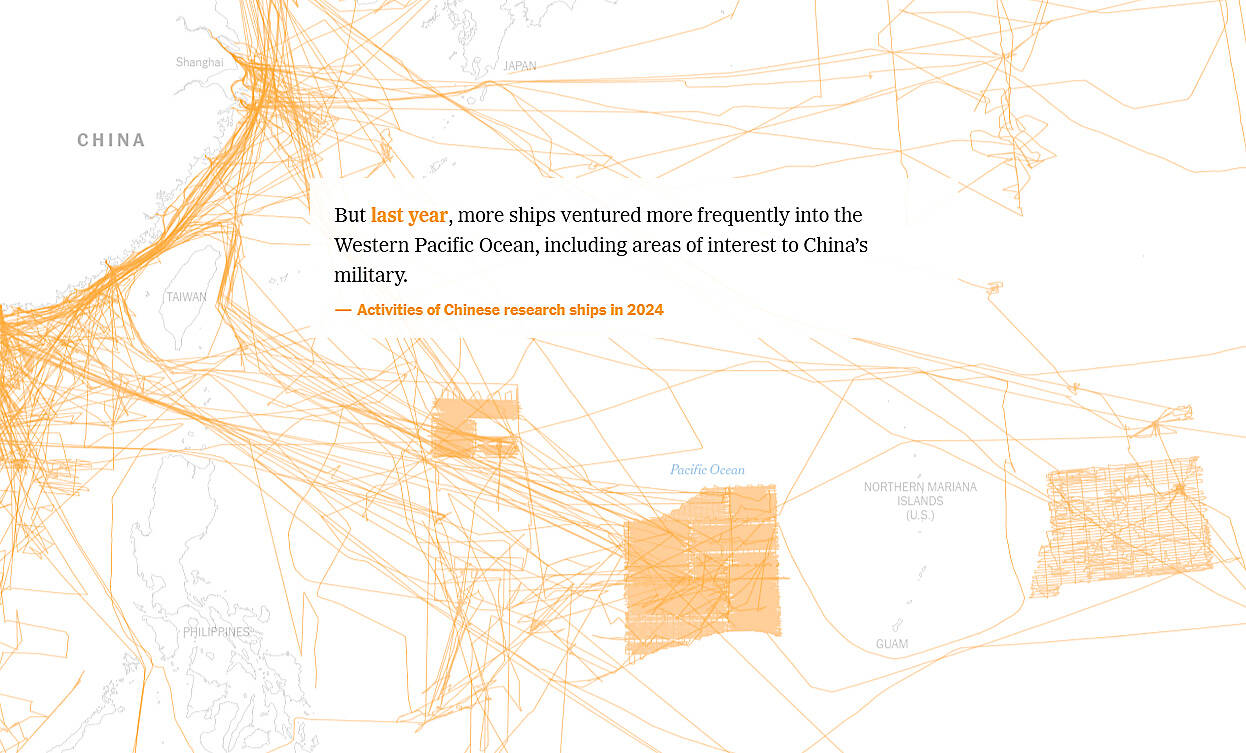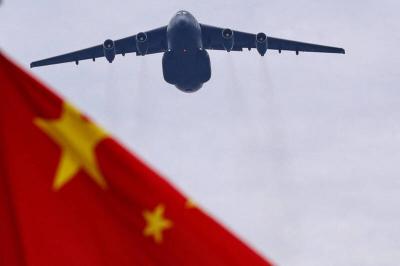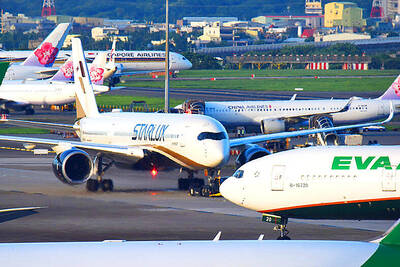China’s oceanographic survey and research ships are collecting data in the Indo-Pacific region — possibly to aid submarine navigation, detect or map undersea cables, and lay naval mines — activities that could have military applications in a conflict with Taiwan or the US, a New York Times report said.
The article, titled “China Surveys Seabeds Where Naval Rivals May One Day Clash,” was written by Chris Buckley and published on Thursday.
Starboard Maritime Intelligence data revealed that Chinese research ships last year repeatedly scanned the ocean floor east of Taiwan’s maritime border, and about 400km east and west of Guam; “waters that China’s navy considers strategically vital,” it said.

Photo: screengrab from New York Time’s Webpage
Last year, six research ships made 25 passes in parallel lines through the waters off Taiwan’s east coast, the article said.
Chinese ships frequently navigated close to Taiwan’s 12 nautical mile (22km) territorial sea boundary, but never crossed it, meaning Taipei could do little to object, it added.
They also moved in parallel lines and grid formations, “precise patterns that experts said suggested a methodical effort to collect information about the seabed that could, among other things, support military operations,” it said.
The majority of China’s research ships are civilian, run by government agencies, universities and institutes, which allows them to attract less attention and scrutiny than naval vessels, the article said.
Under international law, civilian research ships are allowed to operate in international waters and within other countries’ exclusive economic zones with permission, it said.
However, Ocean Affairs Council Minister Kuan Bi-ling (管碧玲) said that “it’s hard for us to view this situation as normal.”
“The potential military payoff from their research seemed clear,” the article said. “Taiwan’s eastern coast is home to key air and naval bases, and if war broke out, the Chinese navy would try to seize control of the nearby seas.”
Chinese military researchers in 2010 said that understanding the Kuroshio Current northeast of Taiwan would help China “better conceal ourselves and attack our enemies,” it added.
The article highlighted the extensive scope of China’s operations, with the Xiang Yang Hong No. 6 (向陽紅06) having surveyed the seabed surrounding Guam — a US territory that hosts US military forces — an area larger than the UK.
“The tracks are so tightly packed, and all this was done in one year. Clearly, they were doing a bathymetric survey,” said Sen Jan (詹森), a professor of oceanography at National Taiwan University.
Bathymetric surveys use technologies such as sonar to map the contours and features of the seabed.
The article said that the voyages might serve various scientific purposes, including mineral exploration, marine biodiversity research and assessing the effects of climate change. However, “the growing research fleet could give Beijing a powerful advantage in maritime competition with the United States,” it added.
“China’s expanding maritime reach deserves close scrutiny, especially its ‘research’ vessels that map seabeds, deploy sensors and pave way for submarine operations” the article quoted former Australian naval officer Jennifer Parker as saying.
Despite growing concerns, such activities have continued, it said, adding that just last month, the Xiang Yang Hong No. 1 (向陽紅01) and Xiang Yang Hong No.5 (向陽紅五號05) were observed operating in grid-like patterns east of Guam.

Beijing could eventually see a full amphibious invasion of Taiwan as the only "prudent" way to bring about unification, the US Department of Defense said in a newly released annual report to Congress. The Pentagon's "Annual Report to Congress: Military and Security Developments Involving the People's Republic of China 2025," was in many ways similar to last year’s report but reorganized the analysis of the options China has to take over Taiwan. Generally, according to the report, Chinese leaders view the People's Liberation Army's (PLA) capabilities for a Taiwan campaign as improving, but they remain uncertain about its readiness to successfully seize

Taiwan is getting a day off on Christmas for the first time in 25 years. The change comes after opposition parties passed a law earlier this year to add or restore five public holidays, including Constitution Day, which falls on today, Dec. 25. The day marks the 1947 adoption of the constitution of the Republic of China, as the government in Taipei is formally known. Back then the Chinese Nationalist Party (KMT) governed China from Nanjing. When the KMT, now an opposition party in Taiwan, passed the legislation on holidays, it said that they would help “commemorate the history of national development.” That

Trips for more than 100,000 international and domestic air travelers could be disrupted as China launches a military exercise around Taiwan today, Taiwan’s Civil Aviation Administration (CAA) said yesterday. The exercise could affect nearly 900 flights scheduled to enter the Taipei Flight Information Region (FIR) during the exercise window, it added. A notice issued by the Chinese Civil Aviation Administration showed there would be seven temporary zones around the Taiwan Strait which would be used for live-fire exercises, lasting from 8am to 6pm today. All aircraft are prohibited from entering during exercise, it says. Taipei FIR has 14 international air routes and

The Ministry of National Defense (MND) today released images of the military tracking China’s People's Liberation Army (PLA) movements during the latest round of Chinese drills around Taiwan. The PLA began "Justice Mission 2025" drills today, carrying out live-fire drills, simulated strikes on land and maritime targets, and exercises to blockade the nation's main ports. The exercises are to continue tomorrow, with the PLA announcing sea and air space restrictions for five zones around Taiwan for 10 hours starting from 8:30am. The ministry today released images showing a Chinese J-16 fighter jet tracked by a F-16V Block 20 jet and the